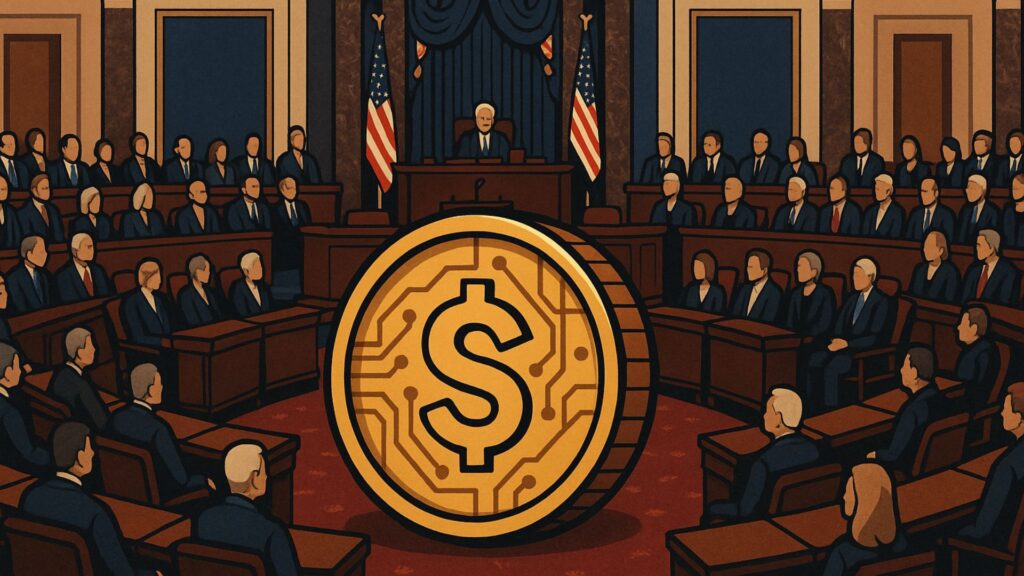The GENIUS Act has passed a key vote in the United States Senate, moving closer to becoming the first federal framework for stablecoin regulation.
With bipartisan backing and a 66–32 result, the bill has entered its final stages, signalling a potential turning point for digital asset oversight in the US.
The GENIUS Act Moves Toward Final Passage
On 20 May 2025, the US Senate voted 66 to 32 to advance the GENIUS Act, overcoming the 60-vote threshold needed to invoke cloture and move the bill closer to full approval.
This procedural milestone allows the Senate to proceed with final deliberations, setting the stage for one of the most significant legislative efforts targeting digital currency infrastructure.
The GENIUS Act, formally known as the Guiding and Establishing National Innovation for U.S. Stablecoins Act, aims to introduce a uniform federal framework for issuing and operating stablecoins.
These are digital tokens pegged to fiat currencies, most commonly the US dollar, and are widely used in payment rails, decentralised finance platforms, and cross-border transactions.
The bill’s earlier version failed to gain traction due to concerns raised by some Senate Democrats, including national security issues and insufficient anti-money laundering protections.
However, after incorporating revisions that address those gaps, several moderate Democrats such as Senators Mark Warner and Adam Schiff shifted their stance, joining Republicans in supporting the motion.
Senator Bill Hagerty, who sponsored the bill, described its advancement as an essential step in modernising the US financial system.
He argued that the bill would not only strengthen consumer protections but also reinforce the dominance of the US dollar in global markets by enabling it to compete in digital form.
Critics have remained vocal, particularly Senator Elizabeth Warren, who opposed the bill because it might allow crypto-affiliated actors to bypass oversight or facilitate financial misconduct.
She expressed fears that the act could be exploited under a future administration with closer ties to crypto interests. Still, her objections were not enough to halt the bill’s momentum.
While this Senate vote does not guarantee final passage, it is the furthest any federal crypto-related legislation has advanced to date.
The House of Representatives is currently drafting its version of the stablecoin framework. If the two chambers can align their language and regulatory goals, the GENIUS Act may soon become the foundation for a national digital asset policy.
In the meantime, the regulatory clarity it represents is already being acknowledged by stakeholders across the finance and technology sectors.
The Senate’s support marks a clear signal that stablecoins will no longer operate in a legal vacuum, and that the government intends to play a more active role in shaping their use.
A Clear Framework Could Unlock Wider Stablecoin Adoption
If fully enacted, the GENIUS Act would give businesses, financial institutions, and technology providers a clear and predictable set of rules for using and supporting stablecoins.
This clarity is expected to remove one of the largest barriers to adoption, particularly for firms that have previously hesitated to integrate stablecoins into their systems due to regulatory uncertainty.
Under the proposed law, stablecoin issuers would need to register with federal authorities, maintain one-to-one fiat reserves, and regularly disclose their backing and audit data.
These requirements would apply equally to legacy financial firms entering the digital space and to existing crypto-native issuers. For developers, banks, and fintech platforms, this uniformity is likely to reduce both legal risk and operational hesitation.
From a business perspective, the availability of a compliant, federally recognised digital dollar could significantly streamline payment processing and improve settlement times, especially for international transactions.
Companies involved in cross-border trade, treasury operations, and remittance services stand to benefit from stablecoins that are not only efficient but also government-sanctioned.
In practical terms, the GENIUS Act could lower the cost and complexity of integrating stablecoin solutions into enterprise systems. Today, companies interested in using stablecoins often face uncertainty around whether they are dealing with legal financial instruments or unregulated assets.
The act would eliminate that ambiguity, making it easier to onboard clients, comply with reporting obligations, and collaborate with banking partners.
It may also foster greater innovation. By removing guesswork around legal compliance, developers and startups could focus more on product design, user experience, and practical applications rather than spending resources on regulatory interpretation.
Larger financial firms, which have traditionally avoided direct exposure to stablecoins, may begin to explore services such as custodial wallets, programmable payments, or tokenised financial products once a clear legal structure is in place.
Internationally, the GENIUS Act could strengthen the position of US-based stablecoins in the global economy.
With jurisdictions such as the European Union and Singapore already implementing digital asset laws, the US has been under pressure to provide its regulatory response.
The act may serve not only as a domestic framework but as a benchmark that other countries consider in shaping their own policies.
However, the benefits of this framework will depend heavily on how the law is implemented. Details such as the licensing process, enforcement authority, and handling of decentralised models will be crucial.
Overregulation could still stifle innovation, while loopholes might erode the protections the act is meant to introduce.
It will require careful coordination between Congress, regulatory agencies, and industry stakeholders to ensure the law delivers on its intent without generating unintended consequences.
Conclusion
The GENIUS Act’s advancement in the Senate marks a pivotal moment in the evolution of US digital asset policy. For the first time, stablecoin issuers and users are on the verge of receiving clear federal guidance, ending years of legal ambiguity.
If the act becomes law, it could enable businesses to adopt stablecoins more confidently, improve payment systems, and position the US as a leader in global digital finance.

